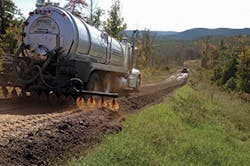Jason Ramsey and Brian Coleman met in 2009 while working for an oilfield service company and two years later formed their own company, Ramco Environmental. Among their many services, they provide dust control for the oil and gas sector.
Ramco Environmental provides its services through an office in Arkansas to serve that state, as well as in Texas and Oklahoma, and an office in Ohio serving that state and West Virginia and Pennsylvania.
The company’s dust control applications are mostly on unpaved access roads to remote drilling sites, including unpaved county roads or township roads leading to the oil and gas sites. About 25% of the work is done on lease roads constructed by the oil and gas companies, says Ramsey.
They use PennzSuppress, an emulsified resin product used for dust control, soil stabilization, and erosion control. Created for use in and around sensitive habitats, it is designed to control dust by up to 98%.
Because Ramco Environmental provides services in several states, Ramsey and Coleman have to stay abreast of the particular state regulations with respect to work on oil and gas sites. Much of their work is in providing dust control in buffers around bridges and waterways.
“It seems that everybody follows the Penn State Center for Dirt and Gravel Road Studies recommendations,” says Ramsey. “PennzSupress is approved by them.”
The Center for Dirt and Gravel Road Studies is an independently funded, nonprofit entity under the Larson Transportation Institute at Penn State specializing in education, outreach, research, and project oversight related to environmentally sensitive maintenance of unpaved roads and trails.
“As long as there is a state approval letter, so far we haven’t run into any kind of rules that say how it needs to be applied or that it’s to be applied in an environmentally responsible manner to reduce the type of runoff,” says Ramsey. “The regulations have been pretty vague. They rely on us as operators and applicators to do what’s right.”
For Ramco Environmental, that means if there is a 50–60% chance of rain for the day, “we’re not going to send our trucks out, because it doesn’t make sense for the chance of the material to run off,” says Ramsey. “If a customer is paying for the road and it’s not going to have enough time to cure and get set up properly, there’s no sense in us doing it.”
How the product is applied is just as important as what product is used, says Ramsey.
“Just because you’ve got a good product—which PennzSuppress is—if you don’t do it the right way, you can mess some things up,” says Ramsey. “We’re very careful in selecting the operators who actually put the material out and who know how to treat the roads. There’s an art to it. Not every road is the same. Sometimes we have to make decisions based on the conditions of the road that we’ve been dispatched to treat.”
The product is applied more quickly on compacted roads so the material doesn’t puddle up and run off. A road that’s been freshly bladed means the product will be applied more slowly, enabling it to absorb better.
Ramsey agrees with the observations of the Pennsylvania Department of Environmental Protection that one of the biggest problems on oil and gas drilling sites is track-out issues from unpaved roads.
“If someone is driving on unstabilized roads after a significant amount of rain, they’re going to track all of that mud and dirt onto a paved road, and once it dries there are dirt clots and rough roads. There are potholes in the untreated roads, so it does create a mess,” he says.
“We feel we can help with that problem, because if we stabilize or treat a road—not just for dust control but over time with several applications—that road becomes a hard, durable surface, reducing the tracking issue with mud. And when it does get hot and dry, it’s basically gluing that roadway together.”
Without proper treatment, fines and larger aggregate are lost during a storm and the road integrity is decreased, Ramsey points out. He says he favors PennzSuppress for its ability to stop migration during a rain event.
“There are a lot of roads we treat and the water will shear off, and when it’s back to dry, the dust control is still down,” he says. “It stays on the road where it’s supposed to and doesn’t end up in ditch lines, creeks, and ponds.”
In one project, Ramco Environmental helped ARG Resources stay in compliance.
“We were doing some work in the Allegheny National Forest due to several oil and gas operators’ activities there. When they are building these roads and making new locations, they were having problems during the rain events,” says Ramsey. “The rain was taking that sediment and putting it into the creeks, which was affecting the drinking water supply.”
In May 2014 when ARG Resources was building its roads, Ramco Environmental applied PennzSuppress to stabilize the roadways to reduce erosion and sediment loss within the Allegheny National Forest.
“They were under a Pennsylvania Department of Protection order to get that under control, so we helped them come into compliance to protect the waters of the state and of the national forest,” says Ramsey. “It’s an ongoing project, and the results have been successful. They’ve come into compliance and they’ve been happy with the application service and with PennzSuppress.”


